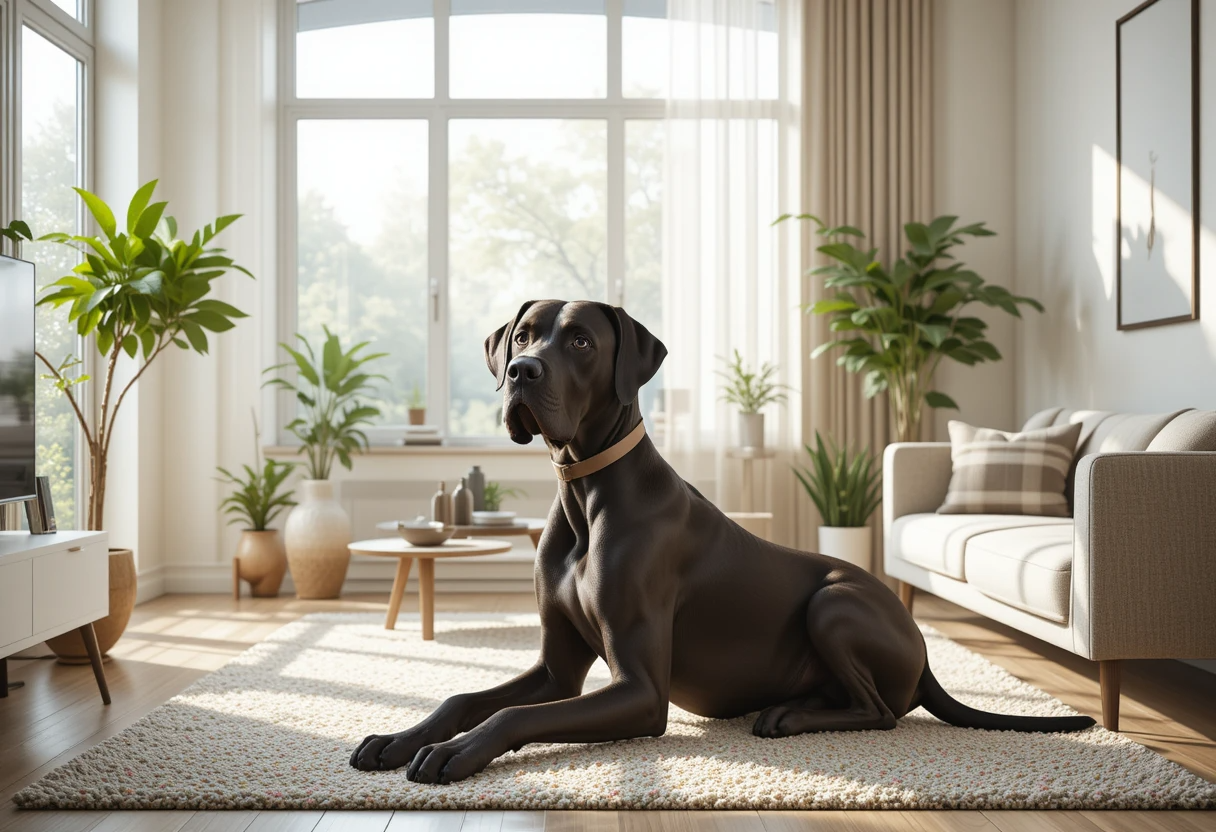Living in an apartment doesn’t mean you have to give up your dream of owning a large dog. While many people assume that best big dog breeds for apartments is an oxymoron, the truth is that several gentle giants can thrive in smaller living spaces when their specific needs are met. The key lies in understanding which breeds have the right temperament, energy levels, and characteristics that make them suitable apartment companions.
Contrary to popular belief, size isn’t the only factor that determines whether a dog will be happy in an apartment. Energy level, exercise requirements, noise tolerance, and temperament play equally important roles. Some large breeds are surprisingly well-suited to apartment living, while certain smaller dogs might struggle without adequate space to burn off their high energy.
This comprehensive guide will walk you through everything you need to know about choosing and living with large dogs in apartments, from the best breeds to practical tips for success.
Why Some Large Dogs Excel in Apartment Living
The Science Behind Apartment-Friendly Big Dogs
Large dogs that excel in apartments typically share several key characteristics. According to research from the American Kennel Club, the most important factors aren’t related to size but rather to:
Energy Levels and Exercise Needs: Many giant breeds require surprisingly less exercise than their smaller, more energetic counterparts. Breeds like Great Danes and Mastiffs are often called “couch potatoes” because they’re content with moderate daily exercise followed by long periods of rest.
Temperament and Noise Levels: The best big dog breeds for apartments tend to be calm, quiet, and well-mannered indoors. They don’t bark excessively or become destructive when left alone for reasonable periods.
Adaptability: These breeds typically adapt well to their owner’s lifestyle and living situation, making them flexible companions for urban environments.
Debunking Common Myths
Myth 1: “Big dogs need big yards” Reality: Many large breeds are less active indoors than smaller breeds. A Great Dane might be perfectly content lounging in a studio apartment, while a Jack Russell Terrier could drive neighbors crazy with constant activity.
Myth 2: “Apartment living is cruel for large dogs” Reality: As long as their physical and mental needs are met through regular exercise and stimulation, many large breeds thrive in apartments. Quality of life depends more on the owner’s commitment than living space size.
Top 8 Best Big Dog Breeds for Apartments
1. Great Dane: The Gentle Giant
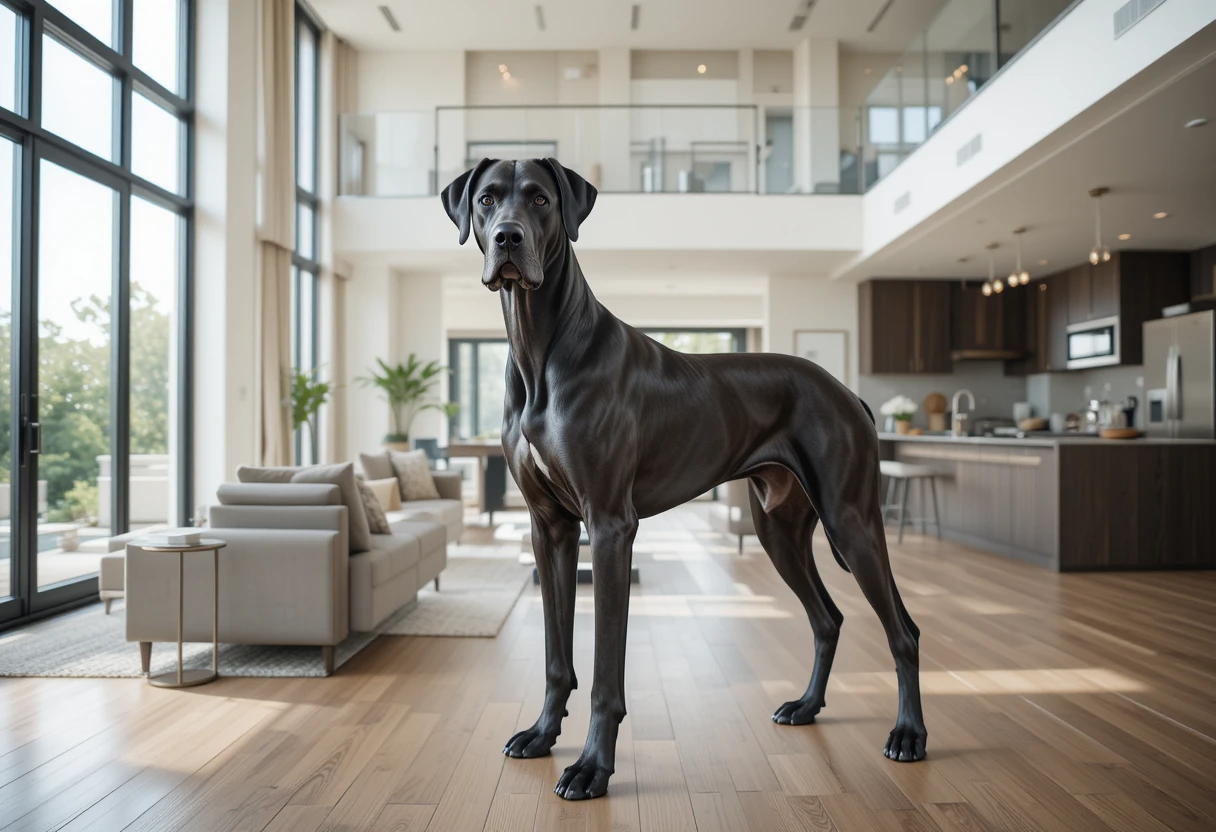
Size: 28-34 inches tall, 100-200 pounds Exercise Needs: 30-60 minutes daily
Great Danes top most lists of the best big dog breeds for apartments for good reason. Despite their imposing size, they’re surprisingly well-suited to apartment living. According to dog behaviorists, Great Danes need around 30-60 minutes of exercise per day and spend most of their time sleeping or lounging.
Why They Work in Apartments:
- Extremely calm and gentle temperament
- Low to moderate exercise requirements
- Quiet indoors with minimal barking
- Content to relax for long periods
Considerations:
- Require adequate ceiling height and floor space
- Short lifespan (8-10 years) due to size
- Can be challenging to navigate around in tight spaces
2. Greyhound: The Retired Athlete
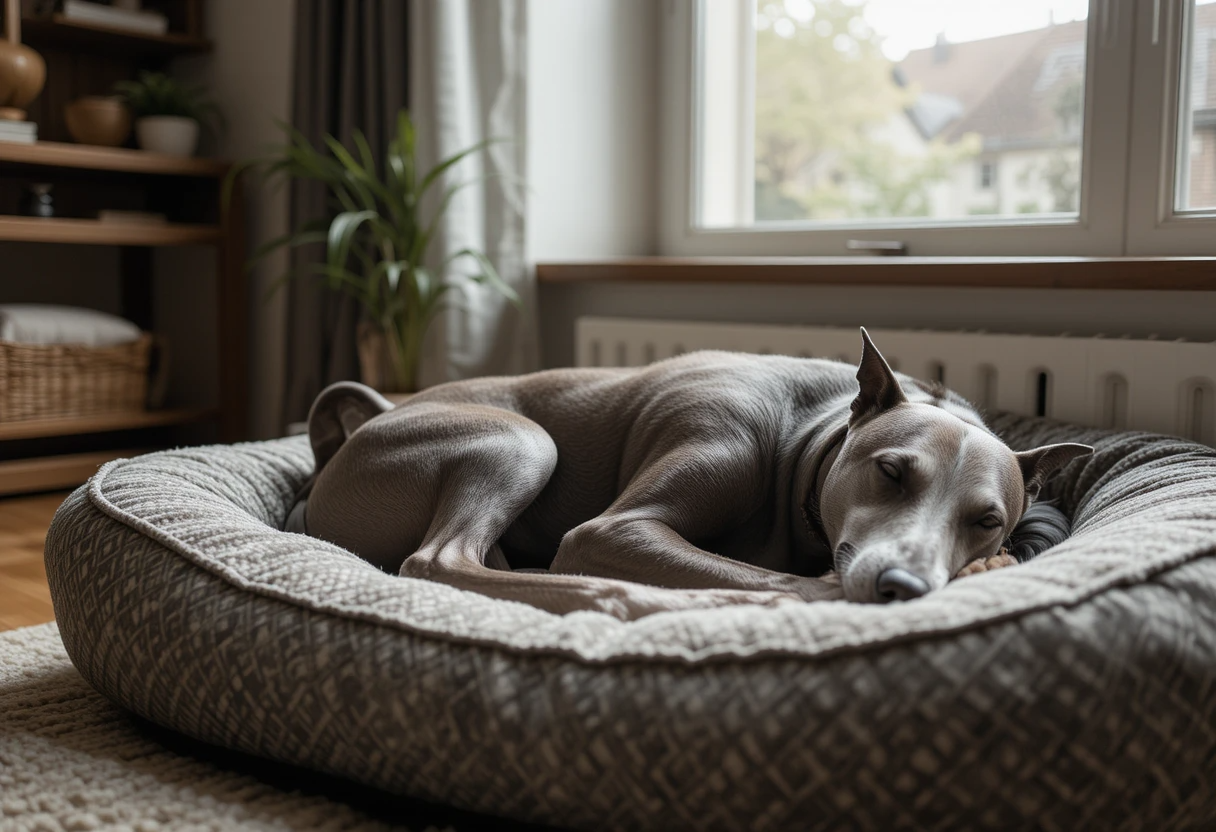
Size: 27-30 inches tall, 50-85 pounds Exercise Needs: 20-30 minutes daily
Often called “40-mph couch potatoes,” Greyhounds are among the most apartment-friendly large breeds. Racing Greyhound adoption organizations consistently recommend them for apartment living due to their surprisingly low energy levels indoors.
Why They Work in Apartments:
- Extremely low energy when not exercising
- Quiet and rarely bark
- Sleep 16-18 hours per day
- Gentle, calm demeanor
Considerations:
- Need secure outdoor areas due to high prey drive
- Sensitive to extreme temperatures
- Require soft bedding for comfort
3. English Mastiff: The Laid-Back Guardian
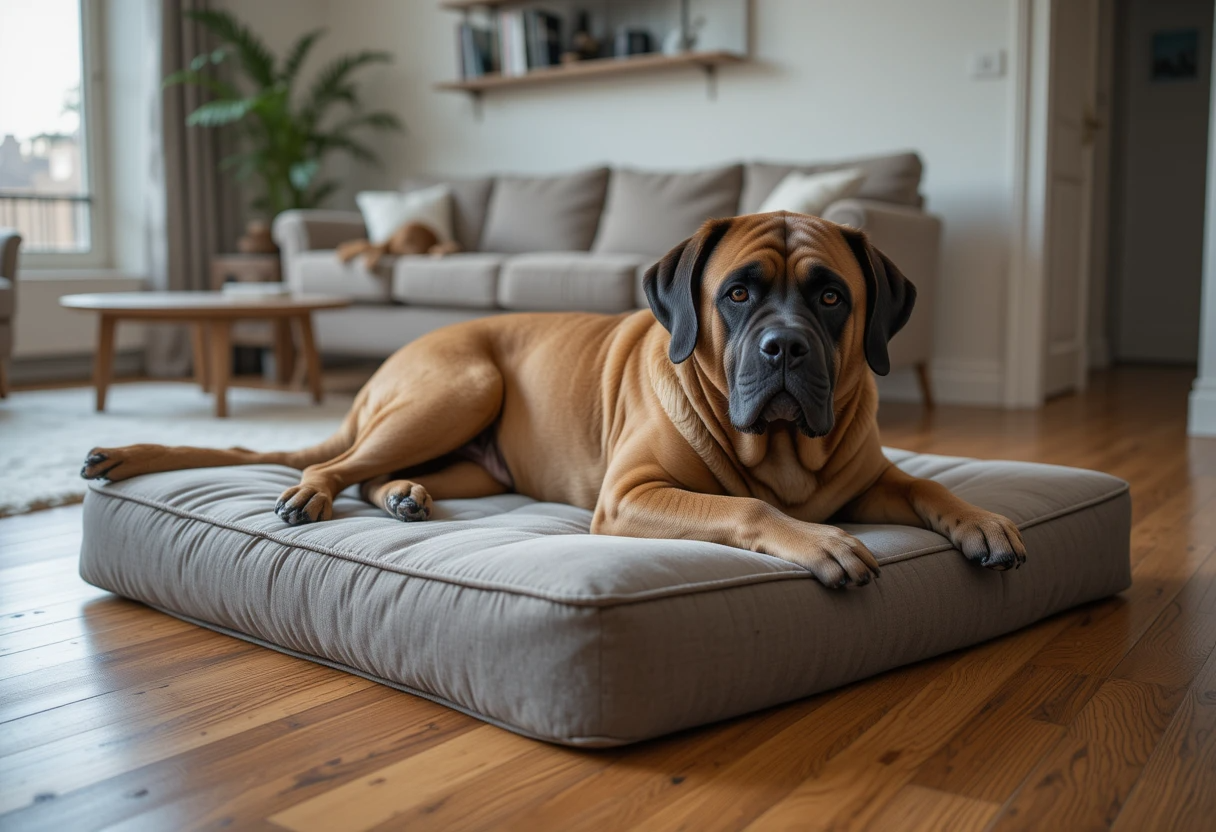
Size: 27-32 inches tall, 120-220 pounds Exercise Needs: 30-45 minutes daily
English Mastiffs are massive dogs with surprisingly moderate exercise needs. Pet care experts note that their gentle temperament and low activity level can make adult Mastiffs fine apartment companions.
Why They Work in Apartments:
- Very calm and docile nature
- Lower exercise requirements than most breeds
- Excellent with children and other pets
- Not prone to destructive behavior
Considerations:
- Drool significantly
- Large size requires adequate space for comfort
- Can be protective, requiring proper socialization
4. Newfoundland: The Gentle Water Dog
Size: 26-28 inches tall, 100-150 pounds Exercise Needs: 30-60 minutes daily
Despite their size, Newfoundlands can adapt to apartment living when their exercise needs are met. Their calm, patient nature makes them excellent apartment companions for those willing to provide regular outdoor time.
Why They Work in Apartments:
- Exceptionally gentle and patient
- Calm indoors with moderate energy
- Excellent with children (“nanny dogs”)
- Intelligent and eager to please
Considerations:
- Heavy shedding requires regular grooming
- Love water and swimming for exercise
- Can be prone to drooling
5. Standard Poodle: The Athletic Aristocrat
Size: 22+ inches tall, 45-70 pounds Exercise Needs: 60-90 minutes daily
Standard Poodles combine intelligence with moderate size, making them excellent apartment dogs for active owners. Their hypoallergenic coat is an added bonus for apartment living.
Why They Work in Apartments:
- Highly intelligent and trainable
- Hypoallergenic, non-shedding coat
- Adaptable to various exercise routines
- Quiet and well-mannered indoors
Considerations:
- Require regular professional grooming
- Need substantial mental stimulation
- Higher exercise requirements than other breeds on this list
6. Bernese Mountain Dog: The Gentle Swiss
Size: 24-27 inches tall, 70-115 pounds Exercise Needs: 30-60 minutes daily
Bernese Mountain Dogs are known for their gentle, friendly nature, making them suitable for apartment living despite their size. They’re particularly good with families and children.
Why They Work in Apartments:
- Gentle, patient temperament
- Moderate exercise requirements
- Good with children and other pets
- Generally quiet indoors
Considerations:
- Heavy shedding, especially seasonally
- Shorter lifespan (6-8 years)
- Can be prone to separation anxiety
7. Clumber Spaniel: The Laid-Back Sporting Dog
Size: 17-20 inches tall, 55-85 pounds Exercise Needs: 30-45 minutes daily
Clumber Spaniels are the most relaxed of the sporting group, making them unexpected but excellent apartment dogs. Their calm nature and moderate size work well in smaller spaces.
Why They Work in Apartments:
- Calm, easy-going personality
- Lower energy than most sporting breeds
- Generally quiet and well-behaved
- Adapts well to indoor living
Considerations:
- Seasonal shedding
- Can be prone to weight gain without proper exercise
- May drool moderately
8. Bullmastiff: The Gentle Guardian
Size: 24-27 inches tall, 100-130 pounds Exercise Needs: 30-45 minutes daily
Bullmastiffs are powerful but surprisingly gentle dogs that can work well in apartments. Their moderate exercise needs and calm demeanor make them suitable for urban living.
Why They Work in Apartments:
- Naturally calm and gentle
- Moderate exercise requirements
- Excellent guard dogs without excessive barking
- Patient with children
Considerations:
- Can be stubborn, requiring consistent training
- May drool and snore
- Need early socialization
Essential Requirements for Apartment Living with Large Dogs
Space and Layout Considerations
Minimum Space Requirements: While there’s no official standard, experts recommend enough space for large dogs to stand, turn around, and lie down comfortably. For most large breeds, this means at least 400-600 square feet of living space.
Layout Optimization:
- Clear pathways for easy movement
- Designated sleeping area with orthopedic bedding
- Access to windows for mental stimulation
- Non-slip flooring to prevent injuries
Exercise and Mental Stimulation
Daily Exercise Requirements: Most apartment-friendly large dogs need 30-90 minutes of exercise daily, depending on the breed. This should include:
- Two walks of 15-30 minutes each
- One longer exercise session (hiking, dog park, swimming)
- Indoor play and mental stimulation activities
Mental Stimulation Strategies:
- Puzzle toys and treat-dispensing games
- Training sessions (5-10 minutes, multiple times daily)
- Rotating toy selection to maintain interest
- Indoor obstacle courses or agility equipment
Building and Neighbor Considerations
Lease and HOA Requirements: Before choosing a large dog for apartment living, verify:
- Pet policies and breed restrictions
- Weight limits (typically 20-50 pounds in restricted buildings)
- Pet deposits and monthly fees
- Required documentation (vaccination records, training certificates)
Neighbor Relations:
- Choose quiet breeds to avoid noise complaints
- Maintain consistent exercise schedules
- Address barking or behavioral issues promptly
- Consider professional training for better apartment manners
You can also follow our Best Crate Schedule for Puppy at Night: Sleep Peacefully with This Easy Routine guide to help your puppy settle easily at night.
Practical Tips for Success with Big Dogs in Small Spaces
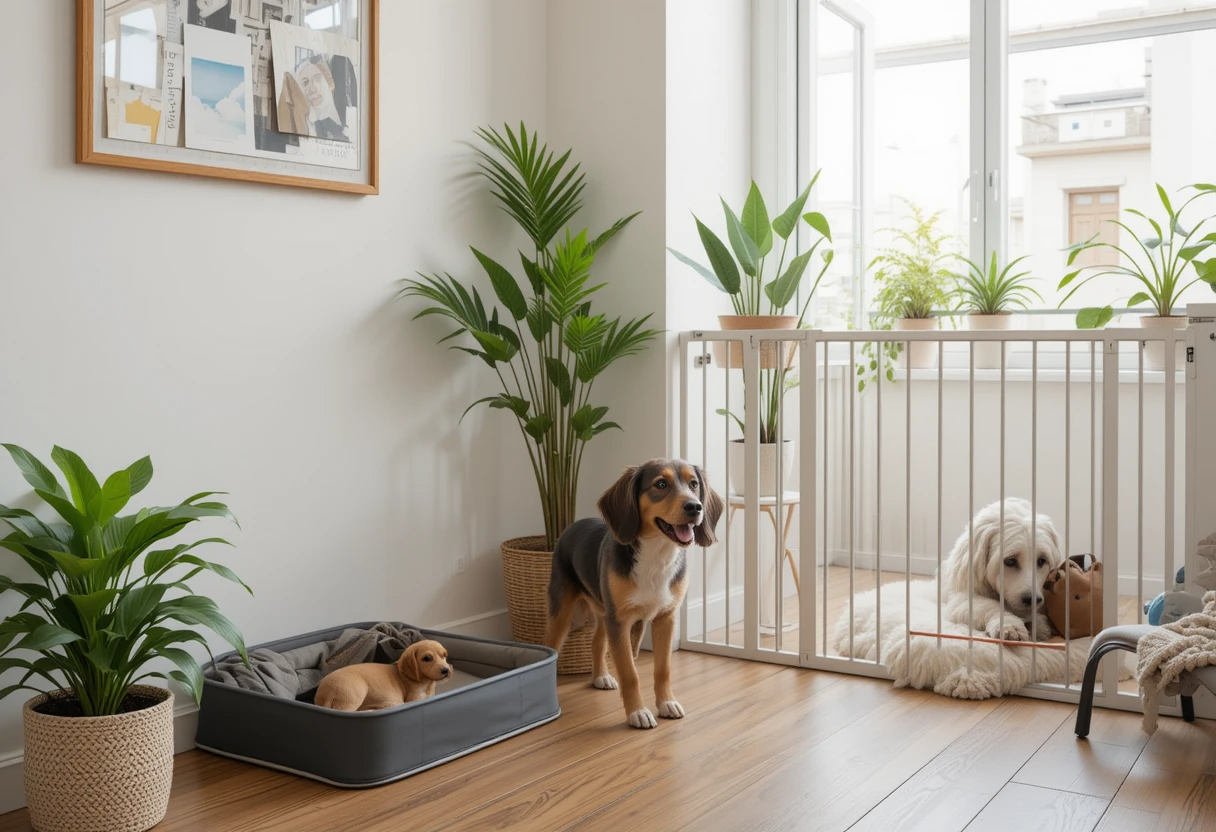
Creating an Optimal Living Environment
Space Management:
- Use vertical storage to maximize floor space
- Invest in furniture that doubles as dog storage
- Create designated areas for feeding, sleeping, and play
- Ensure adequate ventilation for larger dogs who heat up quickly
Safety Modifications:
- Secure potentially dangerous items out of reach
- Use baby gates to create boundaries if needed
- Ensure balcony safety with appropriate barriers
- Remove or secure items that could be knocked over
Training and Behavior Management
Essential Training Commands:
- “Settle” or “place” for designated resting areas
- “Quiet” to manage barking
- “Wait” for doorways and elevators
- Loose leash walking for crowded areas
Behavior Prevention:
- Establish routines to reduce anxiety
- Use positive reinforcement training methods
- Address behavioral issues early with professional help
- Provide adequate mental stimulation to prevent boredom
Health and Wellness in Apartments
Regular Health Monitoring:
- Monitor weight carefully as large dogs in apartments are prone to weight gain
- Watch for signs of joint problems from hard flooring
- Ensure adequate exercise to maintain muscle tone
- Regular veterinary checkups to catch issues early
Nutrition Considerations:
- Feed high-quality food appropriate for the dog’s age and activity level
- Monitor portion sizes carefully
- Provide elevated feeding stations for larger breeds
- Ensure adequate water access, especially after exercise
Common Challenges and Solutions
Addressing Typical Problems
Space Limitations: Challenge: Large dogs may feel cramped or unable to move freely Solution: Maximize floor space, use outdoor areas frequently, consider doggy daycare for additional space and socialization
Exercise Inadequacy: Challenge: Insufficient exercise leading to behavioral problems Solution: Create structured exercise schedules, use local dog parks, consider professional dog walking services
Noise Complaints: Challenge: Barking or movement causing neighbor complaints Solution: Choose naturally quiet breeds, use training to address barking, consider soundproofing measures
Breed Restrictions: Challenge: Many apartments have breed or size restrictions Solution: Look for pet-friendly buildings, consider emotional support animal certification if appropriate, provide references and training documentation
Financial Considerations
Initial Costs:
- Pet deposits: $300-$1000
- First-time setup: $500-$1500
- Training and supplies: $200-$800
Ongoing Expenses:
- Monthly pet rent: $25-$100
- Food and supplies: $100-$200/month
- Veterinary care: $1000-$3000/year
- Professional services (grooming, walking): $100-$500/month
For new dog owners, following a proper routine is crucial. You can also check out our Puppy Schedule 8 Weeks Old – Free, Vet-Approved Daily Routine Inside to help you get started with your puppy’s daily care.
Making the Decision: Is a Large Dog Right for Your Apartment?
Self-Assessment Questions
Before committing to one of the best big dog breeds for apartments, honestly evaluate:
Lifestyle Compatibility:
- Can you provide 1-2 hours of exercise daily?
- Are you home enough to meet the dog’s social needs?
- Can you handle the financial commitment?
- Do you have experience with large breeds?
Living Situation:
- Does your lease allow large dogs?
- Do you have nearby outdoor spaces for exercise?
- Can you handle potential noise or space issues?
- Are you prepared for the long-term commitment (8-15 years)?
Success Factors
High Success Indicators:
- Active lifestyle with time for daily exercise
- Experience with dogs or commitment to training
- Stable living situation and finances
- Access to outdoor spaces and dog-friendly amenities
Warning Signs:
- Hoping a large dog will be content with minimal exercise
- Tight budget with little room for unexpected expenses
- Frequent travel or very long work hours
- Uncertain housing situation
FAQs
Can large dogs really be happy in apartments?
Yes, many large dogs can be very happy in apartments when their physical and mental needs are met. The key is choosing breeds with naturally calm temperaments and moderate exercise requirements, such as Great Danes, Greyhounds, and Mastiffs. Studies show that giant breed dogs often do extremely well in apartment living when their owners provide adequate exercise, mental stimulation, and proper training.
How much exercise do apartment dogs need daily?
Most large apartment dogs need 30-90 minutes of exercise daily, depending on the breed. Dog behaviorists recommend that dogs should be walked at least three times a day, with two longer walks lasting at least an hour each. This routine generally keeps most dogs happy and healthy, particularly for those living in apartments without yards.
What are the biggest challenges of having a large dog in an apartment?
The main challenges include limited space for movement, meeting exercise requirements, potential noise complaints, and breed restrictions. Pet experts note that successful apartment living with large dogs requires creative space management, consistent exercise routines, proper training, and good neighbor relations. Financial considerations like pet deposits and monthly fees also add to the challenges.
Are there apartment size requirements for large dogs?
While there’s no universal standard, USDA guidelines suggest that dogs need enough space to stand, turn around, and lie down comfortably. For large breeds, this typically translates to at least 400-600 square feet of living space. However, the quality of exercise and mental stimulation matters more than absolute square footage.
What’s the best way to find apartments that allow large dogs?
Look for buildings that explicitly advertise as “pet-friendly” or “no breed restrictions.” Real estate experts recommend searching specifically for apartments without breed restrictions, preparing documentation like training certificates and veterinary records, and being upfront about your dog’s size and breed. Consider working with a realtor who specializes in pet-friendly housing.
Conclusion
Choosing one of the best big dog breeds for apartments can be incredibly rewarding when done thoughtfully. The key to success lies in selecting a breed whose temperament and energy level match your living situation, then committing to meeting their physical and mental needs consistently.
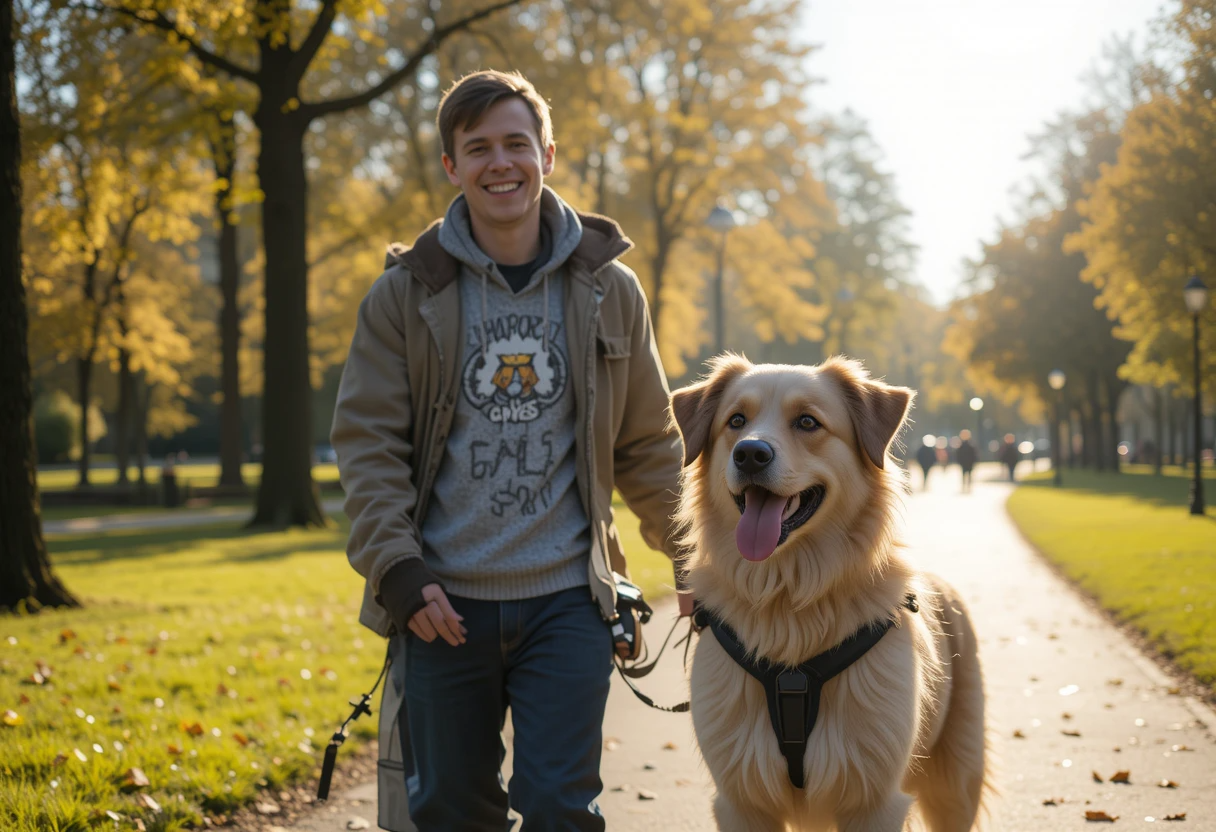
Remember that while breeds like Great Danes, Greyhounds, and Mastiffs can thrive in apartments, they still require dedicated exercise, training, and care. The size of your living space matters less than your commitment to providing a high quality of life for your canine companion.
Before making your decision, spend time with the specific breed you’re considering, talk to current owners, and honestly assess your lifestyle and capabilities. With proper preparation and commitment, you can successfully share your apartment with a gentle giant who will bring years of love and companionship to your urban lifestyle.
The best apartment dogs, regardless of size, are those whose needs are understood and met by their devoted owners. Choose wisely, prepare thoroughly, and enjoy the unique joy that comes from sharing your home with one of these magnificent large breeds.
If you’re planning to adopt a large breed, it’s also important to stay aware of their health. Check out 15 Dangerous Signs in Dogs You Should NEVER Ignore to keep your furry friend safe and healthy.
